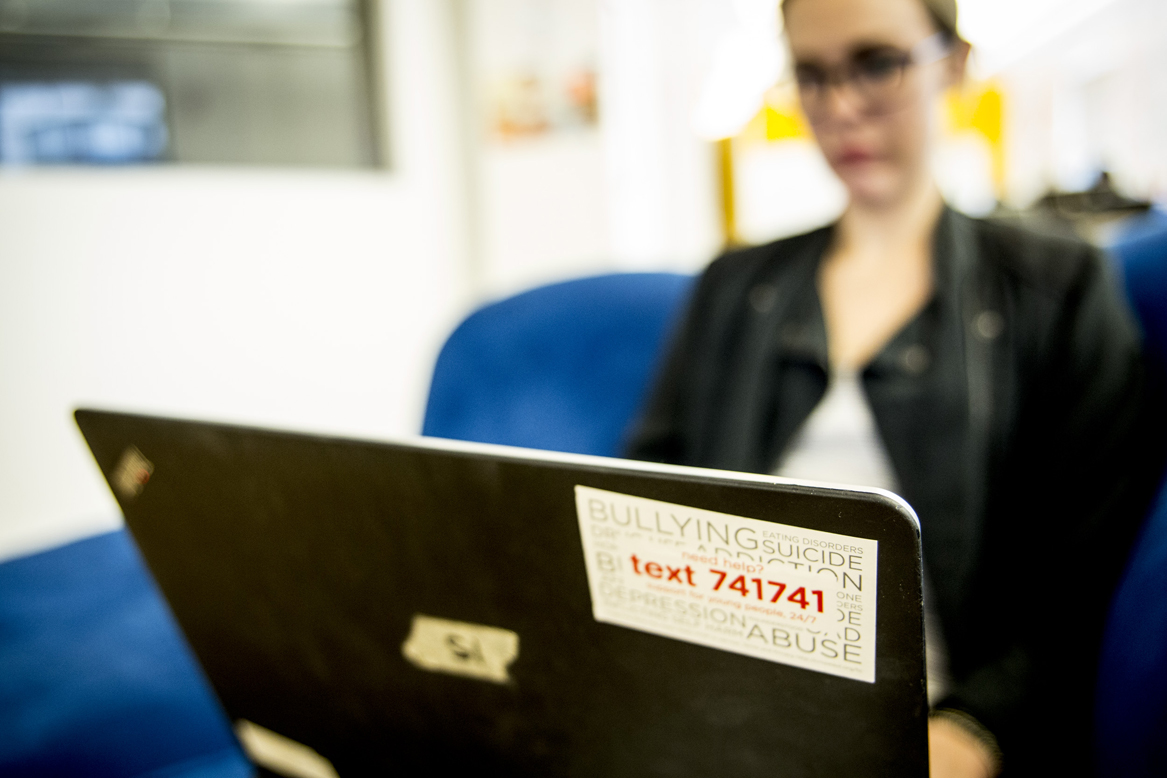
Specialists at Crisis Text Line chat with teenagers in distress through a web platform. This month, the service will respond to its 2 millionth message. Photo: Keri Goff
Teenagers love to text—their thumbs pound out an average of 3,339 texts per month. Crisis Text Line turns this into a way to help teens through their hardest times: family issues, stress or suicidal thoughts. Trained counselors text back and forth with advice and resources—and, in the process, collect (anonymous) data that could lead to better policy to protect teens.
Crisis Text Line gets 11,000 messages from teenagers in distress a day—the service will respond to its 2 millionth message this month. And founder Nancy Lublin says the service simply wouldn’t exist if she hadn’t been asked to give a TED Talk about it.
Lublin met TED curator Chris Anderson in December 2011, and told him something she’d noticed while working with teens at DoSomething.org: They’re shockingly honest via text message. She wondered out loud if a Crisis Text Line might be more effective than traditional crisis hotlines.
Anderson was intrigued, and asked Lublin to talk about it at TED University, a special TED session where audience members are invited to give short talks. Lublin said yes, but there was a problem: Crisis Text Line was only an idea. To give a talk on it, she’d need to figure out exactly what it could be.
So she started researching. Lublin came across some other crisis-response services that used text messaging, but many of them were using it for a single issue, often suicide prevention. She felt that much could be improved in the breadth of service offered, and in the user experience for counselors.
“Giving that TED U talk forced me to organize my thoughts coherently,” says Lublin now, two years after stepping onto the TED stage. “It made my crystallize what it is and what it isn’t … There were so many things that I wanted to explain about the logistics, about the ‘how’ it would work, and at the end of the day, that’s not as interesting about the ‘why’ it would work. I tried to explain the ‘why’ so it would make sense, and make it more relatable to everybody in the audience.”
In the talk, Lublin does a beautiful job of that, sharing her vision for how texting could save lives by getting teens help in the moment and by gathering real-life data on their issues. As she finished her talk, she got a standing ovation.
“I had so many people come up to me and say, ‘My daughter is anorexic and needs this,’ or tell me about a bullying situation. All of them said, ‘The primary way that I communicate with my child is text,’” says Lublin. “It affirmed that there was a real need for this.”

Nancy Lublin clarifies the idea behind Crisis Text Line at TED U in 2012. Photo: James Duncan Davidson
Invigorated by the response to her vision, she started writing a plan for the Crisis Text Line, then raising the money to start it.
“It was really hard to raise the money,” she says now. “It took much longer than it should’ve for something that’s this clear and obvious.” The talk helped on this front. “It gave legitimacy—it was such a stamp of approval. I don’t think it actually led to money, but it definitely opened doors.”
Eighteen months after giving her talk, Lublin made the first two hires for the Crisis Text Line: a chief technology officer and a data scientist. Rather than setting them up in an office, Lublin sent them out to visit crisis call centers around the country. There, they watched how counselors responded to calls and took note of the problems and hangups in the systems they were using. It helped the two design a new system for counseling via text message.
“The user interface for counselors is really friendly and clean,” says Lublin. “The counselors have had a terrific response. They’re like, ‘This is exactly what I’ve been wishing for.’ Because we sent our geeks on the road.”
The Crisis Text Line went live on August 1, 2013. When a teenager texts the service, the message gets pinged to a certified counselor who sees it onscreen. From there, the counselor texts back and forth to get more information and offer resources. The average conversation runs for 66 minutes.
And if a specialist needs to go on a bathroom break, or simply feels they don’t have the experience to respond to a particular problem, they can ask for backup without disrupting the conversation by transferring the call.
“Two counselors—it might be someone in Miami and someone in Seattle—can look at the same thread on the screen from the texter and, in the pop-up, talk about how best to respond to this person,” Lublin says. “From the user’s perspective, they haven’t been passed off to anybody — they’re still just talking to Crisis Text Line. But from the counselor’s perspective, the counselor has been supported.”
In her talk, Lublin outlines why the Crisis Text line could be so vital—beyond helping teens one-on-one, it can provide data with implications for parents, teachers, school administrators, even policy makers. The Crisis Text Line plans to open up its data in June. (You can look at a sample set now.)
“In real time, you’ll be able to look up any area code, any time of day, any day of the week, any issue and see what’s going on. Some of the learnings have already been kind of mind-blowing,” says Lublin.
For example, Crisis Text Line data reveals that teens struggle much more with eating disorders on Sunday night and Monday than at any other point during the week.
“Think about what that data does for a school. It changes how school guidance counselors can watch kids at risk; how the school food vendors should plan meals for Monday; how teachers should watch kids; how families should watch kids; how the local intake center should staff up,” says Lublin. “That one piece of information can inform so many people. It changes so many things.”
Another data point revealed an unexpected patterns for cutting and self-harm. It doesn’t just happen at night—teens are doing it during school hours. “That changes how people think about it. Like maybe [a school] shouldn’t have a separate staff and student bathroom. Maybe having the staff use the same bathroom as students is a better idea,” says Lublin.
Bob Filbin, Crisis Text Line’s chief data scientist, says the organization just closed its first data visualization contest to help make this information more understandable. “Opening up the data could inform academic research, public policy and community efforts to improve outcomes for teens in crisis,” he agrees.
“And we can also use data internally to improve our service.” Data could give Crisis Text Line specialists the power to predict what’s going on with the teens they’re texting. Late this fall, the service will launch a tool to help counselors identify patterns they might not notice on their own.
“A little pop-up will say to the counselor, ‘This texter has used these six words. There’s a 90% match with alcohol abuse. You might want to ask one of these questions,’” Lublin says. “It’ll mean we won’t miss issues—we’ll catch imminent harm situations even more quickly.”
As Lublin points out, crisis call centers have been around for decades—they’ve shown great success and developed processes about when to interact with police, EMTs and other authorities. The Crisis Text Line is a chance to use these proven methods with a new technology, one that teenagers are comfortable with — and that offers new ways to support staff specialists, who are doing emotionally difficult work.
Speaking of staff, Lublin says her TED Talk helped on this front too. The talk has helped her recruit top talent, and brought in board members and volunteers who are passionate about helping teens. For adults, “It’s often the first introduction,” says Lublin.
Teenagers, on the other hand, are much more likely to hear about the service in other ways. When the Crisis Text Line launched in Chicago, and El Paso, Lublin met with local school officials and community members to let them know it was available. They also sent a text message out to teens in the areas who were in DoSomething’s database. From there, news of the service spread by word-of-mouth. “Kids know other kids,” says Lublin.
The talk has spread interest to other countries—the Crisis Text Line has gotten inquiries about extending the service to Turkey, France, the U.K., Canada and South Africa. “We’ve been talking to one major global carrier,” says Lublin. “Right now, for this year, it’s expand the service in the U.S. and roll out the data. Then in 2015, the plan is to roll it out around the world.”
But for now, Lublin and her team keep their heads down, responding to texts.
“We’ve got so much to do—we feel like we’re only at the beginning,” says Lublin. “There’s so many more kids that we could be helping.”

Two Crisis Text Line specialists consult on a text chain. It was very important to Lublin that counselors feel supported. Photo: Keri Goff
Do you have a story of how a TED Talk has led to tangible change? Email kate (at) ted (dot) com to tell her about it.
Comments (12)